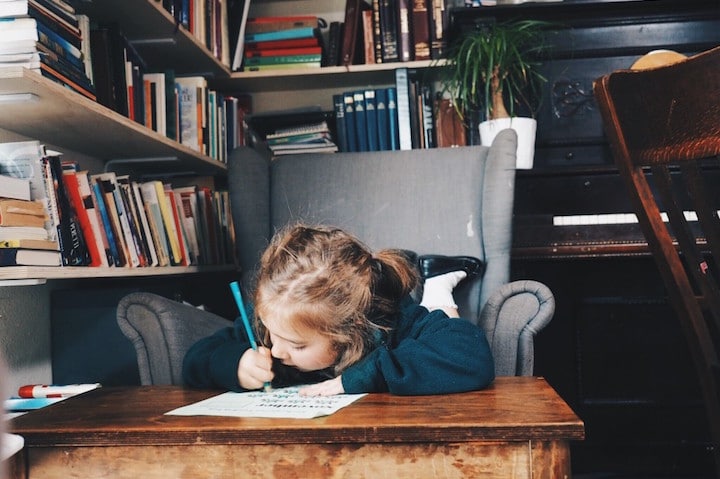15 states with the best public education
These states offer top public education that can be gentler on your wallet.

Providing your child with a good education is a concern at the forefront of most parents’ minds. In fact, when we surveyed Millennial parents, we found that 30% named education as a top financial priority.
Whether it’s paying for private education or purposefully buying a home in the best school district, if it’s financially feasible, most parents will do anything to give their kids the very best. Fortunately, some states offer top public education that can be a little gentler on your wallet. So that brings up the question: Do your state’s education standards align with your own hopes and dreams for your little ones?
Unfortunately, according to the most recent National Assessment of Education Progress (NAEP), sometimes called the Nation’s Report Card, test scores and educational outcomes are slipping. On average, assessment scores from the 2022-2023 school year in both reading and math declined across all demographics since the previous survey during the 2019-2020 school year.
Despite a disappointing national trend (particularly after the pandemic), some states are performing better than others. To determine which states provide the best public education for children, we compiled data on test scores, resource availability, and graduation rates using reports from the NAEP, the Department of Education, and the National Center for Education Statistics.
In this article:
How the states stack up
We evaluated states across three quality measures:
- Academic performance (based on NAEP scores)
- Resource availability (based on per-student spending and student-to-teacher ratios)
- Public high school graduation rates
In general, researchers at online life insurance agency Haven Life found substantial variation in statistics across the country.
Student-to-teacher ratios vary widely, with Vermont allocating as few as 10.8 students per teacher on average. At the other end, Arizona more than doubled that, averaging 23.6 students per teacher. The national average is 15.9 students per teacher.
Performance varied as well, though it’s notable that the floor for graduation rates has risen, while the ceiling has remained the same. Five years ago, high school graduation rates ranged from 69-91% nationwide. The most recent NCES data puts the lowest graduation rate at 77% in Arizona and New Mexico, while nine different states have graduation rates over 90%.
In addition to overall rankings of the best public education by state, we also learned the following:
- State with the best NAEP test scores: Massachusetts (284 math, 269 reading)
- State with the lowest student-to-teacher ratio: Vermont (10.8 students per teacher)
- State spending the most money per student: New York ($27,506 per student)
- States with the highest high school graduation rate: Iowa and West Virginia (92% each)
Whether you’re planning to move or want to know where your state stands, below are the top 15 states for public education in the U.S.
15. Montana
- Overall Education Rank: 15th
- Academic Performance: 15th
- Resource Availability: 18th
- Graduation Rate: 27th (86%)
Although it has fairly average scores in resource availability and graduation rate, Montana’s academic performance places it in the 15th spot on this list. A math score of 277 puts it in 14th, while its 261 in reading ranks 17th for a combined average of 15th place out of all states.
14. Kansas
- Overall Education Rank: 14th
- Academic Performance: 35th
- Resource Availability: 15th
- Graduation Rate: 19th (88%)
Despite below-average test scores, Kansas schools average 13.6 students per teacher and allocate $14,885 per year to each student’s education. Its 88% graduation rate pulls it into 14th place overall.
13. Wisconsin
- Overall Education Rank: 13th
- Academic Performance: 5th
- Resource Availability: 19th
- Graduation Rate: 7th (90%)
Wisconsin scored very highly in academic performance, with 281 in math and 262 in reading, and its graduation rate of 90% puts it 7th in the country. Unfortunately, some slightly stretched resources knock Wisconsin down somewhat in the rankings. Student-to-teacher ratios are 14.2, with per-student spending sitting at $14,913.
12. Nebraska
- Overall Education Rank: 12th
- Academic Performance: 14th
- Resource Availability: 13th
- Graduation Rate: 18th (88%)
Nebraska has an 88% graduation rate, student-to-teacher ratios of 13.7, and test scores ranking 12th in math and 23rd in reading, for an average rank of 14th in academic performance. Nebraska public schools spend an average of $14,988 per student, 23rd among all states.
11. Rhode Island
- Overall Education Rank: 11th
- Academic Performance: 32nd
- Resource Availability: 10th
- Graduation Rate: 29th (84%)
Rhode Island ranks 35th and 27th in math and reading test scores, respectively, with a graduation rate of 84%. Its student resources include average spending of $18,448 on each of its 13.4 students per teacher.
10. Pennsylvania
- Overall Education Rank: 10th
- Academic Performance: 23rd
- Resource Availability: 9th
- Graduation Rate: 24th (87%)
Pennsylvania has average graduation rates and test scores. It ranks 23rd in math with 274 points and 24th in reading with 259 points, spending $19,195 per student. It allocates 13.9 students per teacher.
9. North Dakota
- Overall Education Rank: 9th
- Academic Performance: 22nd
- Resource Availability: 11th
- Graduation Rate: 12th (89%)
Although North Dakota’s test scores are slightly above average, scoring 278 in math and 258 in reading, a high graduation rate and availability of resources make it 9th on this list. The student-to-teacher ratio averages 12.5 students per teacher, one of the lowest in the country.
8. Maine
- Overall Education Rank: 8th
- Academic Performance: 27th
- Resource Availability: 8th
- Graduation Rate: 23rd (87%)
Average graduation and academics are balanced out by increased resources, with 12.2 students per teacher and spending of $17,580 per student.
7. Wyoming
- Overall Education Rank: 7th
- Academic Performance: 8th
- Resource Availability: 7th
- Graduation Rate: 40th (82%)
Wyoming’s graduation rate is on the lower end at 82%, but its test scores and resource availability are both in the top 10. Wyoming scored 281 in math and 261 in reading, placing 7th and 15th, respectively.
6. New York
- Overall Education Rank: 6th
- Academic Performance: 21st
- Resource Availability: 3rd
- Graduation Rate: 28th (84%)
New York averages $27,506 per student, the highest spending of any other state. The students average 12.4 per teacher.
5. New Hampshire
- Overall Education Rank: 5th
- Academic Performance: 7th
- Resource Availability: 5th
- Graduation Rate: 17th (88%)
New Hampshire scored highly in both academic performance and resource availability. With 12.1 students per teacher, the second lowest rate in the country, New. Hampshire pupils earned an average of 279 in math and 263 in reading.
4. Connecticut
- Overall Education Rank: 4th
- Academic Performance: 10th
- Resource Availability: 4th
- Graduation Rate: 16th (88%)
Connecticut ranks in the top 10 due to its math and reading scores of 276 and 264, respectively. It has 12.4 students per teacher and a graduation rate of 88%, which places it as the fourth-best public school system on our list.
3. Vermont
- Overall Education Rank: 3rd
- Academic Performance: 9th
- Resource Availability: 2nd
- Graduation Rate: 35th (83%)
Despite scoring lower for graduation rates, Vermont’s test scores and resources earn it third place here. It has the best student-to-teacher ratios of anywhere, with 10.8 students to every teacher. Its per-student spending is $22,956, and it has some top-10 test scores, individually ranking 16th in math and 4th in reading.
2. Massachusetts
- Overall Education Rank: 2nd
- Academic Performance: 1st
- Resource Availability: 6th
- Graduation Rate: 11th (89%)
Massachusetts combined test scores were the highest in the nation. Scoring 284 in math and 269 in reading, Massachusetts averages per-student spending of $20,875, student-to-teacher ratios of 12.8, and an 89% high school graduation rate.
1. New Jersey
- Overall Education Rank: 1st
- Academic Performance: 2nd
- Resource Availability: 1st
- Graduation Rate: 3rd (91%)
New Jersey ranks number one in resource availability, second in academic performance, and third in graduation rates and comes out as the best state for public education in the U.S. Its 12.1 students per teacher are allocated the second-highest spending in the country, at $23,000 each. Test scores place students 4th in math at 281 and the top reading score in the country at 270.
Methodology & full results
The overall education rank is a composite ranking based on the following data for public school students. The table below includes the raw data used in this analysis.
Academic performance (60%)
Academic performance was ranked based on the most recent scores from the National Assessment of Academic Progress (NAEP) Math and Reading scores among 8th-grade students (2022). The NAEP assigns scores on a 0-500 scale, where 500 is the best possible score. The national public average reading score was 216, and the national public average for math was 273, according to the 2022 assessments.
Resource availability (20%)
Statistics were compiled on student-to-teacher ratios and per-student spending to assess resource availability. Both student-to-teacher ratios and average per-student spending were taken from the National Center for Education Statistics (NCES) Digest of Education Statistics published in 2021.
Graduation rate (20%)
Public high school graduation rates are taken from the most recent NCES annual reports covering the 2019-2020 school year. The overall average adjusted cohort graduation rate was 87% for that period.
Chart with compiled data: https://docs.google.com/spreadsheets/d/1o-DfZ8O_XY5Ywmse0YInXrBBkOfNLQfWRRWQFPPsF40/edit?usp=sharing
Our editorial policy
Haven Life is a customer-centric life insurance agency that’s backed and wholly owned by Massachusetts Mutual Life Insurance Company (MassMutual). We believe navigating decisions about life insurance, your personal finances and overall wellness can be refreshingly simple.
Our editorial policy
Haven Life is a customer centric life insurance agency that’s backed and wholly owned by Massachusetts Mutual Life Insurance Company (MassMutual). We believe navigating decisions about life insurance, your personal finances and overall wellness can be refreshingly simple.
Our content is created for educational purposes only. Haven Life does not endorse the companies, products, services or strategies discussed here, but we hope they can make your life a little less hard if they are a fit for your situation.
Haven Life is not authorized to give tax, legal or investment advice. This material is not intended to provide, and should not be relied on for tax, legal, or investment advice. Individuals are encouraged to seed advice from their own tax or legal counsel.
Our disclosures
Haven Term is a Term Life Insurance Policy (DTC and ICC17DTC in certain states, including NC) issued by Massachusetts Mutual Life Insurance Company (MassMutual), Springfield, MA 01111-0001 and offered exclusively through Haven Life Insurance Agency, LLC. In NY, Haven Term is DTC-NY 1017. In CA, Haven Term is DTC-CA 042017. Haven Term Simplified is a Simplified Issue Term Life Insurance Policy (ICC19PCM-SI 0819 in certain states, including NC) issued by the C.M. Life Insurance Company, Enfield, CT 06082. Policy and rider form numbers and features may vary by state and may not be available in all states. Our Agency license number in California is OK71922 and in Arkansas 100139527.
MassMutual is rated by A.M. Best Company as A++ (Superior; Top category of 15). The rating is as of Aril 1, 2020 and is subject to change. MassMutual has received different ratings from other rating agencies.
Haven Life Plus (Plus) is the marketing name for the Plus rider, which is included as part of the Haven Term policy and offers access to additional services and benefits at no cost or at a discount. The rider is not available in every state and is subject to change at any time. Neither Haven Life nor MassMutual are responsible for the provision of the benefits and services made accessible under the Plus Rider, which are provided by third party vendors (partners). For more information about Haven Life Plus, please visit: https://havenlife.com/plus





